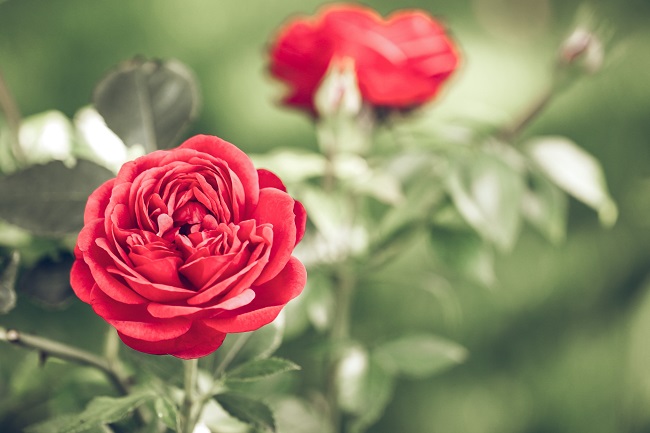Bountiful rose blooms grace gardens in every state in the union during this early summer month, whether it’s the first crop of flowers where winters are cold or in the warmer climes where the roses have already been blooming for several months. It demonstrates one of the best of the characteristics of modern roses; they’re perennials that grow and bloom everywhere throughout the growing season.

I don’t know about you, but I’m a cutter. I want lots of roses in vases around the house, adding their fragrance to the serenity of the bedroom, their hospitality to the dining room table, and their wondrous beauty to a coffee table or entrance hall. The best roses for cutting, of course, are the hybrid teas with their one perfect bloom atop a long leafy stem. So, I grow more hybrid teas than any other type of rose.
But floribunda and shrub roses also make wonderful rose arrangements, especially the roundy-moundy, crammed-into-a-bowl creations that Martha Stewart has made so popular. A single floribunda stem will carry half-a-dozen or more individual blooms that dazzle the eye and fill the bowl. I grow lots of shrubs and floribundas, too, but I don’t often use them in arrangements. They’re the big flower producers that keep color in my garden after I’ve cut every hybrid tea in sight!
Maybe you’d rather enjoy your roses outdoors where they keep the landscape alive with color all summer. But whatever you choose to do with your roses, you’re going to have to cut them at some point.
“Deadheading” or removing the spent flowers is essential to fast and continual flower production all summer. Whether you cut them for the vase or wait until they’ve gone by, cut long stems on hybrid teas so the new flower that grows will be big, atop a sturdy cutting stem. Sometimes, a hybrid tea will grow with one large center bud and two smaller buds, one on each side of the big center one. Pinch out the sidebuds when they’re very small so the plant puts its energy into that one big center flower. When cutting or deadheading roses whose flowers grow in clusters, the floribundas, shrubs, and shrublets, be sure to cut the main stem well below the short, fringy stems that were the individual roses in the cluster. A new big cluster will grow in its place.
If you’ve ever noticed, the large center bud in a cluster of roses will always bloom first, while the other flowers in the cluster will open more slowly. If you deadhead just that spent center blossom, the cluster has a big hole in the center where a flower would look much better. A little trick is to pinch out that center bud when the cluster of buds is forming, long before it begins to open. The other buds in the cluster will fill in the hole in the center, and all the buds that remain will open at the same time. It’s a great, colorful display.
Climbers, on the other hand, are deadheaded a little differently. Whether you grow the large-flowered, one-to-a-stem climbers or the showier cluster bloomers, the flowers, sprout from the budeyes all along the length of a big main cane. When you cut or deadhead those blooms, cut the short flower stem in half so that new flowers will grow from the old, shortened stem.
Both cutting flowers for the vase or deadheading spent blooms are considered pruning. You can also prune your roses to keep them in bounds or in a shape that may be more pleasing to the eye. Pruning encourages roses to grow, so don’t ever be afraid to cut something that is in your way or isn’t pretty.
Tree roses, for example, or standards as they’re sometimes called, can get leggy and out of control if you wimp out with the pruners. Be ruthless without removing more than a third or so of the leaves and reap the benefits of sturdy canes and big showy flowers.
Just think you have the whole summer left to take control of your rose garden and turn it into the showpiece you always intended it to be!
Ann Hooper is a certified American Rose Society Consulting Rosarian.
Related Articles & Free Email Newsletter
A Miniature Rose Prospers Outdoors
Selecting the Right Tool Makes Pruning Easier




Comment here